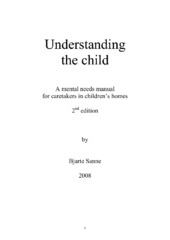| dc.description.abstract | Giving adequate care for children in children’s homes (we prefer the expression “children’s home” to “orphanage”, since there are few institutions where all the children are real orphans) is very demanding and difficult. Therefore, a child should not be placed in a children’s home unless it is impossible for his biological family to take care of him, and unless it is impossible to provide him with adoptive parents or a foster home. However, the reality is that a large number of children grow up in children’s homes. The aim of this manual is to contribute to the equipment of caregivers working in such institutions. It has been developed in an Asian context, but we hope that it can be useful also in other parts of the world. We believe the following to be true: What I hear, I forget. What I see, I remember. What I do, I know. What I discover, I use. Therefore, when teaching caregiving staff from this manual, we hope that the teachers will allow time for their students to reflect on, and when possible, discover themselves the principles of these teachings. Also, both practical skills and attitudes need to be demonstrated. For these reasons we hope that the content of this book will be passed on to the staff on an individual basis or in small groups, and in a practical way. Time and again we stress that children need individual attention and training. So do caregivers, to a certain extent, to adopt healthy attitudes and to develop their caregiving skills. The title “Understanding the child” has been chosen because we believe that understanding brings about love and compassion, the most important ingredients in child rearing. We have made our best to base the teaching on up-to-date research and literature. (This has also caused some of the content to be rather complicated and detailed.) However, it has been unavoidable to introduce information that is less objective and acknowledged. Whether you are a Buddhist, a Hindu, a Muslim, a Christian, an atheist or profess another faith or religion, we hope that you will find this book useful. The author himself is a Christian and finds much relevant information about child rearing in the Bible. However, all biblical references and examples are marked with an asterisk (*), to show those not interested what they can skip when reading. In this manner the rest of the text is free from religious content. Hopefully you will find the structure of this book logical. Firstly, to understand the child it is important to have some knowledge on child development (section 3). Secondly, we need to know about children’s rights and needs (section 4). Thirdly, it is time to study how children’s homes should be organised to prepare for these needs to be met (section 5). Fourthly, we will see how caretakers can fulfil the basic needs of children (section 6). In our view, this is the most important section of the book. Fifthly, there will be teachings on some common problems that children may face, particularly in residential care, and what you can do to help them out (section 7). It is very important to study section 6 carefully (The basics of child rearing) before you apply the principles given in section 7 (Some problems and what you can do). The structure of each chapter is simple: For most subjects there is a summary of the teaching, then the teaching itself, followed by some references to the Bible, marked* (Bible version: the New International Version if not otherwise stated). There will also be some suggestions to work tasks that can be carried out to improve the care of the children. Finally, main references have been listed. In some chapters we have included information that may be useful without being essential. Such information is printed in this size letters. To make the text more readable we have chosen to use “he” instead of “he/she” when referring to a child or another person. If anyone should wonder about this choice, it does not express any prejudice on our part. Also, as you have already noted, the author uses “we” (instead of “I”) to refer to himself. The word “reward” is often used instead of the technically more correct expression “reinforcement”, because the latter is a concept that is more difficult to explain and translate. The definitions of and difference between these concepts are found in chapter 7.3. Major changes have been made from the first edition (which has just been translated into the Myanmar language) to the second. The following chapters are new: 3.3 Development of school-age children, 6.6 Teaching problem solving, emotional regulation and friendship skills, 7.6 Some specific behavioural problems, 7.8 HIV and AIDS, 7.9 Some academic problems, 7.10 Problems related to natural functions, and 8.2 Resources. Except from 7.9 and 7.10, the content of these chapters is entirely new. We have also expanded chapter 6.5 considerably. Behavioural problems have been devoted four chapters (7.3-7.6) because of their frequency, and because of the importance of handling these problems in an appropriate way. Minor revisions and expansions have also been done for several of the other chapters. | en_US |
